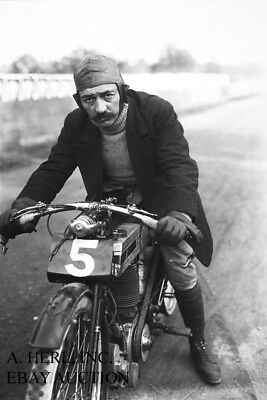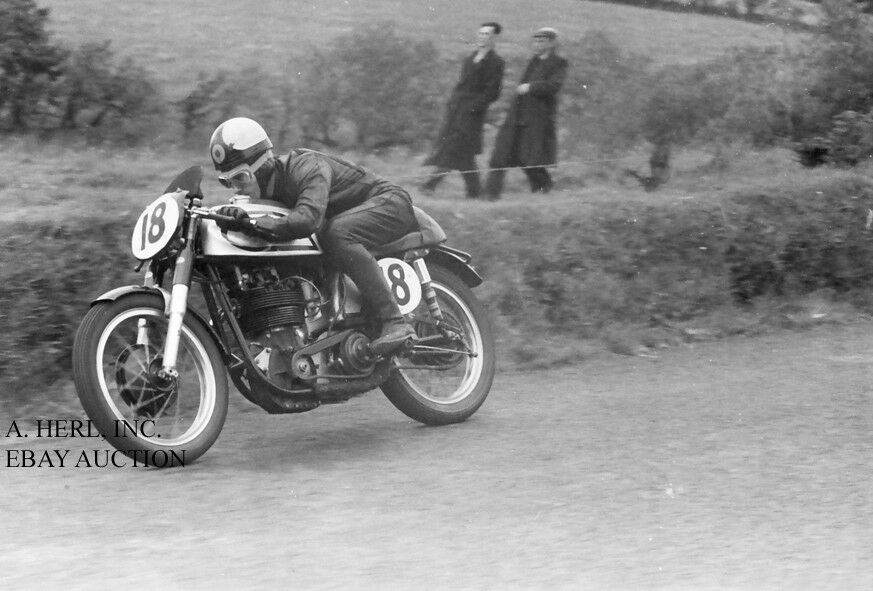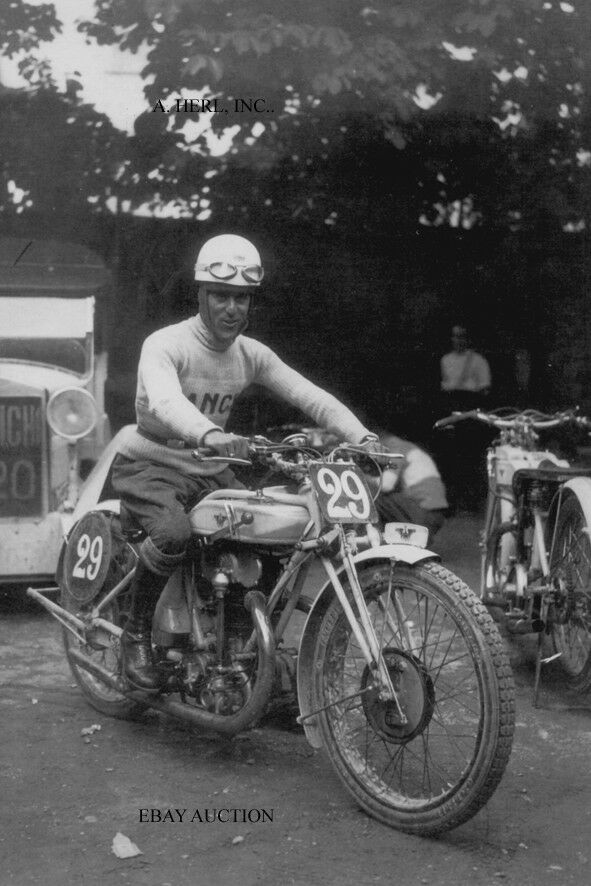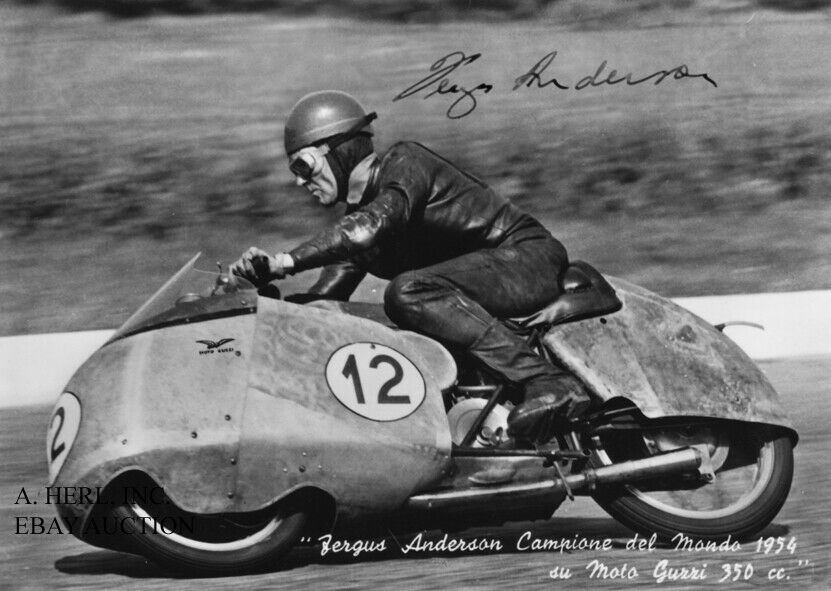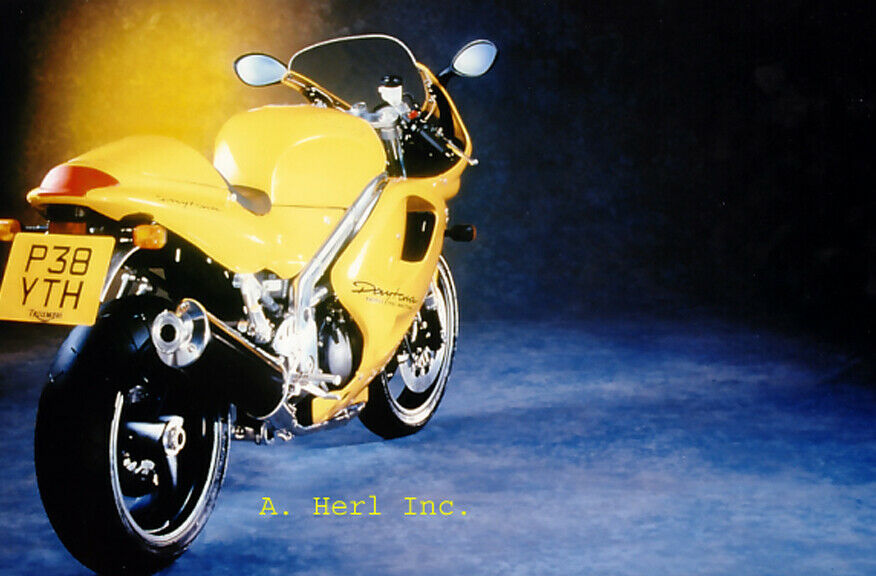-40%
Harley-Davidson 30.5ci 4-valve racer Becker 1923 French Grand Prix Bol d'Or
$ 5.14
- Description
- Size Guide
Description
A superb and rare photo of HD factory riderBecker
and his
Harley-Davidson 30.50ci 4-valve (!!) factory sidecar racer
during the 1923 French Grand Prix at Bol d’Or.
Harley-Davidson
has a long and very interesting history that started as early as in 1901. That year, William S. Harley, age 21, drew up plans for a small engine with a displacement of 7.07 cubic inches (116 cc) and four-inch (
102 mm
) flywheels. The engine was designed for use in a regular pedal-bicycle frame. Over the next two years Harley and his childhood friend Arthur Davidson labored on their motor-bicycle using the northside
Milwaukee
machine shop at the home of their friend, Henry Melk. It was finished in 1903 with the help of Arthur's brother, Walter Davidson. Upon completion the boys found their power-cycle unable to conquer
Milwaukee
's modest hills without pedal assistance. Will Harley and the Davidsons quickly wrote off their first motor-bicycle as a valuable learning experiment. Work immediately began on a new and improved second-generation machine. This first "real" Harley-Davidson motorcycle had a bigger engine of 24.74 cubic inches (405 cc) with 9.75 inches (
25 cm
) flywheels weighing
28 lb
(
13 kg
). The machine's advanced loop-frame pattern was similar to the 1903 Milwaukee Merkel motorcycle (designed by Joseph Merkel, later of Flying Merkel fame). The bigger engine and loop-frame design took it out of the motorized-bicycle category and would help define what a modern motorcycle should contain in the years to come. The boys also received help with their bigger engine from outboard motor pioneer Ole Evinrude, who was then building gas engines of his own design for automotive use on
Milwaukee
's
Lake Street
. The prototype of the new loop-frame Harley-Davidson was assembled in a 10 ft × 15 ft (3.0 m × 4.6 m) shed in the Davidson family backyard. Most of the major parts, however, were made elsewhere, including some probably fabricated at the
West Milwaukee
railshops where oldest brother William A. Davidson was then toolroom foreman. This prototype machine was functional by September 8, 1904, when it competed in a
Milwaukee
motorcycle race held at
State
Fair
Park
. It was ridden by Edward Hildebrand and placed fourth. This is the first documented appearance of a Harley-Davidson motorcycle in the historical record. In January 1905, small advertisements were placed in the "Automobile and Cycle Trade Journal" that offered bare Harley-Davidson engines to the do-it-yourself trade. By April, complete motorcycles were in production on a very limited basis. That year the first Harley-Davidson dealer, Carl H. Lang of
Chicago
, sold three bikes from the dozen or so built in the Davidson backyard shed. (Some years later the original shed was taken to the
Juneau Avenue
factory where it would stand for many decades as a tribute to the Motor Company's humble origins. Unfortunately, the first shed was accidentally destroyed by contractors in the early 1970s during a clean-up of the factory yard.) In 1906, Harley and the Davidsons built their first factory on
Chestnut Street
(later
Juneau Avenue
). This location remains the Motor Company's corporate headquarters today. The first
Juneau Avenue
plant was a 40 by 60-foot (
18 m
) single-story wooden structure. That year around 50 motorcycles were produced. In 1907, William S. Harley graduated from the University of Wisconsin–Madison with a degree in mechanical engineering. That year additional factory expansion came with a second floor and later with facings and additions of
Milwaukee
pale yellow ("cream") brick. With the new facilities production increased to 150 motorcycles in 1907. The company was officially incorporated that September. They also began selling their motorcycles to police departments around this time, a market that has been important to them ever since. Production in 1905 and 1906 were all single-cylinder models with 26.84 cubic inches (439.8 cc) engines. In February
1907 a
prototype model with a 45-degree V-Twin engine was displayed at the Chicago Automobile Show. Although shown and advertised, very few V-Twin models were built between 1907 and 1910. These first V-Twins displaced 53.68 cubic inches (879.7 cc) and produced about 7 horsepower (5.2 kW). This gave about double the power of the first singles. Top speed was about
60 mph
(
97 km/h
). Production jumped from 450 motorcycles in 1908 to 1,149 machines in 1909. By 1911, some 150 makes of motorcycles had already been built in the
United States
– although just a handful would survive the 1910s. In 1911, an improved V-Twin model was introduced. The new engine had mechanically operated intake valves, as opposed to the "automatic" intake valves used on earlier V-Twins that opened by engine vacuum. With a displacement of 49.48 cubic inches (810.8 cc), the 1911 V-Twin was smaller than earlier twins, but gave better performance. After 1913 the majority of bikes produced by Harley-Davidson would be V-Twin models. By 1913, the yellow brick factory had been demolished and on the site a new 5-story structure of reinforced concrete and red brick had been built. Begun in 1910, the red brick factory with its many additions would take up two blocks along
Juneau Avenue
and around the corner on
38th Street
. Despite the competition, Harley-Davidson was already pulling ahead of Indian and would dominate motorcycle racing after 1914. Production that year swelled to 16,284 machines. In 1917, the
United States
entered World War I and the military demanded motorcycles for the war effort. Harleys had already been used by the military in the Pancho Villa Expedition but World War I was the first time the motorcycle had been adopted for combat service. Harley-Davidson provided about 15,000 machines to the military forces during World War I. By 1920, Harley-Davidson was not by far the largest motorcycle manufacturer in the world, though their motorcycles were sold by dealers in 67 countries. Production was 28,189 machines. In
1921, a
Harley-Davidson, ridden by Otto Walker, was the first motorcycle ever in the
USA
to win a race at an average speed of over
100 mph
(
160 km/h
). During the 1920s, several improvements were put in place, such as a new 74 cubic inch (1200cc) V-Twin, introduced in 1922, and the "Teardrop" gas tank in
1925. A
front brake was added in
1928. In
the late summer of 1929, Harley-Davidson introduced its 45 cubic inch flathead V-Twin to compete with the Indian 101 Scout and the Excelsior Super X.
This is a very nice and very rare
non period
photo that reflects a wonderful era of HD motorcycle history in a wonderful way. This is your rare chance to own this photo, therefore it is printed in a nice large format of ca. 8" x 12" (ca.
20 cm
x 30 cm). It makes it perfectly suitable for framing!
You can always contact us for more Harley-Davidson, Excelsior, Indian, Reading Standard,
Thor
, Merkel, Emblem and other motorcycle / automotive photos!
Shipping costs will only be $ 7.00 regardless of how many photos you buy. For 5 or more photos, shipping is free!
(Note: A. Herl, Inc. does not appear on photo, for ebay purposes only)
No copyright expressed or implied. Sold as collectable item only. We are clearing out our archives that we have gathered from various sources.
All items always sent well protected in PVC clear files
and board backed envelopes.
We have photographs that came from professional collections and/or were bought from the original photographer or press studio! They are all of professional and excellent quality.
After many decades of professionally collecting photographs and posters we are clearing out our archives. They make the perfect gift and are perfectly suited for framing. They will look gorgeous unframed and will be a true asset nicely framed with a border. They are a gorgeous and great asset in every home, workshop, workplace, restaurant, bar or club!
First come - first served. And you can always contact us for your requests. Please ask any questions before the auction ends.

